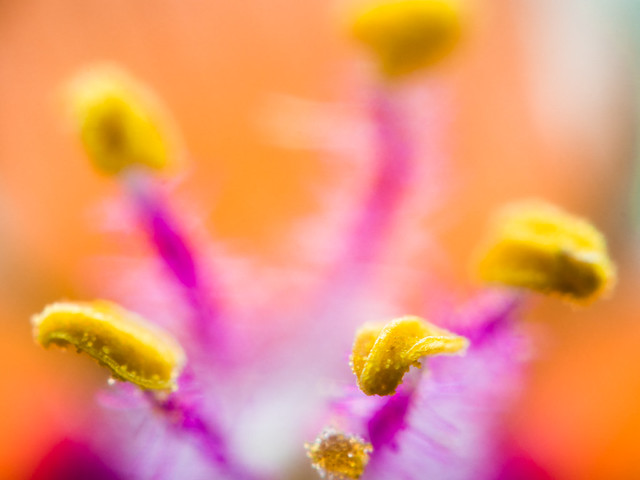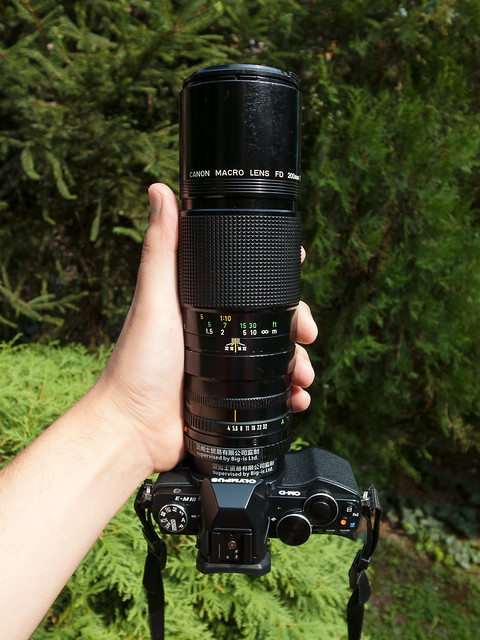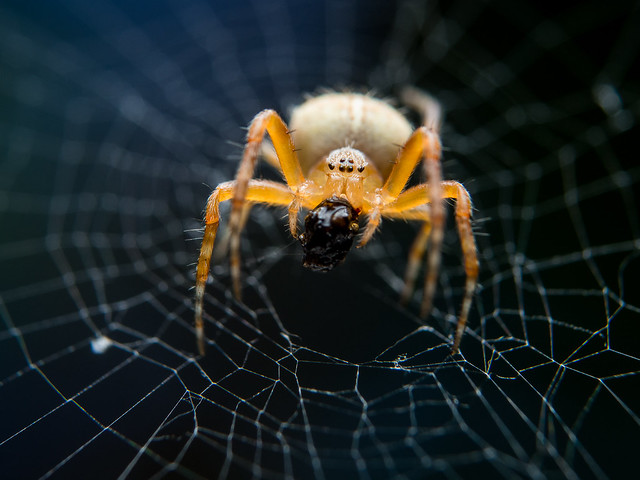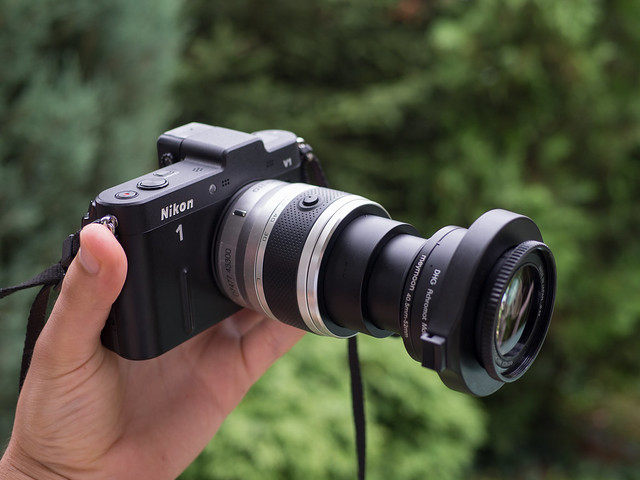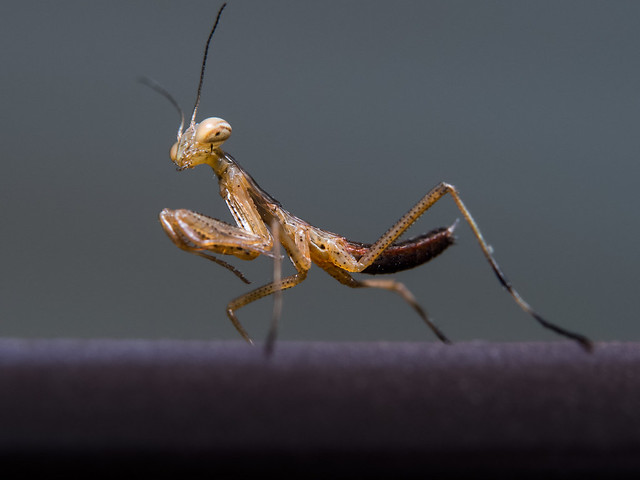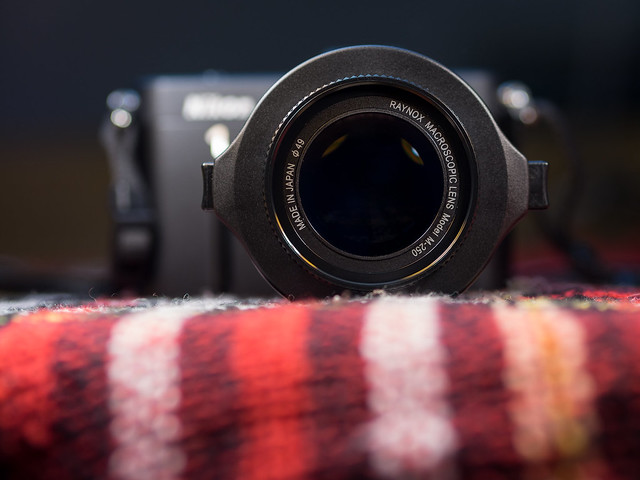After my last post regarding the Cosmicar 8mm f/1.4 CCTV C-mount lens I have purchased a revers mounting ring for micro four thirds. It’s a 55mm to M4/3 mount mounting ring, which is too large for the Cosmicar. I have therefore attached the lens to two step-up rings – a 40.5mm to 52mm and a 52mm to 55mm. It’s not an ideal solution, but I wasn’t able to find a reverse mounting ring with a smaller filter thread. Anyway it works and surprisingly well at that. I haven’t calculated the maximum magnification ratio, but it puts all my other macro setups to shame. See the anthers in the following photo which was shot with the reverse mounted Cosmicar 8mm f/1.4 on my Olympus OM-D E-M10?
Tag: macro
Canon FD 200mm f/4 Macro is the kind of lens I wanted Olympus and Panasonic to release for quite some time now. In my mind smaller sensor formats, like micro four thirds and Nikon 1, are perfectly suited for macro photography – especially for skittish macro subjects, such as damselflies, dragonflies and butterflies. It’s a real shame that neither Olympus/Panasonic nor Nikon have released a long macro lens for their respective systems. In absence of such a lens, the best option is to get a legacy lens and a suitable adapter and focus manually.
I’ve been shooting a lot of macro photos since my last post on this topic. Most of the time – almost exclusively, actually – I’ve used my Nikon 1 V1 and 1 Nikkor 30-110mm f/3.8-5.6, with or without achromatic close-up lenses. You don’t really need a close-up lens or a real macro lens for larger insects like damselflies or dragonflies. The following photos were captured without a close-up lens and show how close you can get to your macro subject with just the 30-110mm.
Note: Click on any of the following photos to view it large.

Damselflies are many a macro photographer’s favorite subject. They are colorful, slim and elegant. When you look at their face, they often appear to be smiling. Described in one word, they are beautiful. They are also very active and wary, which makes them challenging to photograph for novice photographers. But if you are familiar with their behavior, there are ways to trick them into posing for the camera very patiently or even into sitting on your finger. And you don’t even have to get up at 5am, when all insects are slow due to lower temperatures.
Less than a week ago I finished making a macro diffuser for my Meike MK320. Unlike the first version of the diffuser (see here), which was intended to work with the built-in flash of my Olympus OM-D E-M10 and was made of paper – and was therefore fiddly and not very robust – this one is mostly made of cardboard. The inside is layered with aluminium foil, in order to reflect more light and therefore increase effective output and improve flash recycle time.
I’m not entirely sure that I have succeeded in making the setup more efficient, but I’m very satisfied with the look of the photos. The light doesn’t look hard, which is the most important aspect for me.
I’ve included several sample photos taken with the diffuser and the following gear down below: Olympus OM-D E-M10, Olympus M.Zuiko Digital 45m f/1.8, Marumi DHG200 + 5, Raynox DCR-250 and FOTGA extension tubes.
Three weeks ago I bought a used Nikon 1 Nikkor VR 30-110mm f/3.8-5.6 lens for my Nikon 1 V1. It wasn’t exactly in pristine condition, but the price was too tempting to let the opportunity pass. As the luck would have it, my EN-EL15 battery died just several days before. The 30-110mm arrived sooner than my replacement battery from ChiliPower. Since going by its cosmetic condition I wasn’t sure that it would even work, I was biting my nails, waiting to test the lens out. And as you probably know, if you’ve bought enough used gear online, there are many conman out there. Luckily the 30-110mm turned out to be an excellent workhorse in disguise of an ugly duckling. 🙂

Achromatic close-up lenses are one of the most popular options among photographers who want to get a taste of macro photography without breaking the bank. They are a special kind of close-up lenses with multiple lens elements instead of just one. This minimizes chromatic aberration and ensures better image quality at the borders of the frame.
Two highly regarded achromatic lenses are the Marumi DHG200 +5 and Raynox DCR-250. They cost almost the same, around 50-55 bucks. I own both of them and I’m more than satisfied with their build and image quality. That being said, there are some differences that will make you prefer one over the other, unless you want to own both. 😉 So let’s get to it!
I’ve been meaning to post some of my recent macros, which I’ve taken with the trusty old V1, 10-30mm, Marumi DHG200 (check out my review of the Marumi here) and Raynox DCR-250, but unfortunately I’ve had bronchitis the past couple of weeks. I wasn’t really in the mood for blogging.
